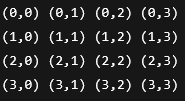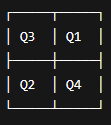[LeHack] - Alpha Walk

Table of Contents
LeHack2025 - This article is part of a series.
Introduction #

- Each matrix is 2^m * 2^m in size
- Each matrix is decomposed into 4 sub-matrices of size 2^m-1 * 2^m-1
- The order of filling is special for the 4 sub-matrices:
- top-right
- bottom-left
- top-left
- bottom-right
- This order is applied recursively
- Each cell of a matrix takes the value depending on its position
For M=1, the matrix is :
3 1
2 4
For M=2, the matrix is :
11 9 3 1
10 12 2 4
7 5 15 13
6 8 14 16
The aim is to find the value in position row=13 371 337, column=73 317 331 for a matrix M=60.
Analysis #
A matrix M=60 of size 2^60 * 2^60 has values ranging from 1 to 2^2x60 = 2^120, so we’ll need to use a language capable of handling large numbers (such as Python).
As the M=60 matrix is absolutely gigantic, it’s not possible to solve the problem by writing a Python script that constructs the matrix and reads the value we’re interested in, as this would take far too long (even with a powerful PC).
Instead of building the matrix by calculating the values of each cell, we position the value of each cell according to their position (row, column), for example with a M=2 matrix:
We then divide the matrix into cadrants! In fact, you can always divide the matrix into 4 parts, whatever its size:

- Q1: top right
- Q2: bottom left
- Q3: top left
- Q4: bottom right
Algorithm #
Thanks to these 2 principles, it’s quite simple to solve the challenge, just follow the algorithm below:
- Determine the frame in which you’re looking for the value, which is easy because you know the position of the value you’re looking for.
- Calculate the offset (= number of cells that have already passed before the current frame)

- Add offset to a global counter.
- Repeat the same algorithm, but the starting matrix is now this quadrant
Solving #
The following Python script takes this algorithm and displays the value of the (13371337, 73317331) cell in a M=60 matrix:
def get_value(r, c, m):
value = 0
for level in reversed(range(m)):
size = 1 << level # 2^level
block_size = 4 ** level
# Determine quadrant and adjust (r, c) accordingly
if r < size and c >= size:
# Top-right
c -= size
quadrant = 0
elif r >= size and c < size:
# Bottom-left
r -= size
quadrant = 1
elif r < size and c < size:
# Top-left
quadrant = 2
else:
# Bottom-right
r -= size
c -= size
quadrant = 3
value += quadrant * block_size
return value + 1 # Add 1 because values are 1-indexed
def get_matrix(size):
mat = []
for i in range(2**size):
ligne = []
for j in range(2**size):
ligne.append(get_value(i,j,size))
mat.append(ligne)
print(mat)
if __name__ == '__main__':
#get_matrix(60)
print(get_value(13371337, 73317331, 60))
🚩 Flag : leHACK{886151997189943915260142838930733156}
